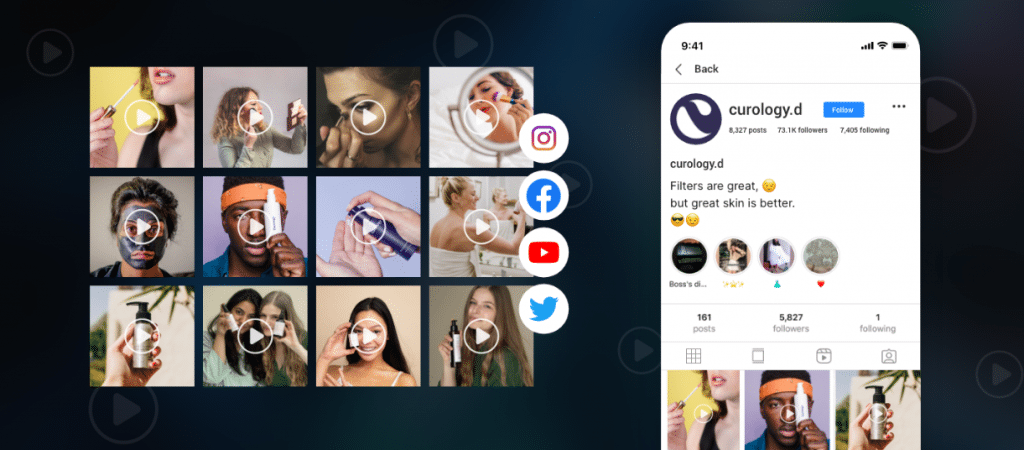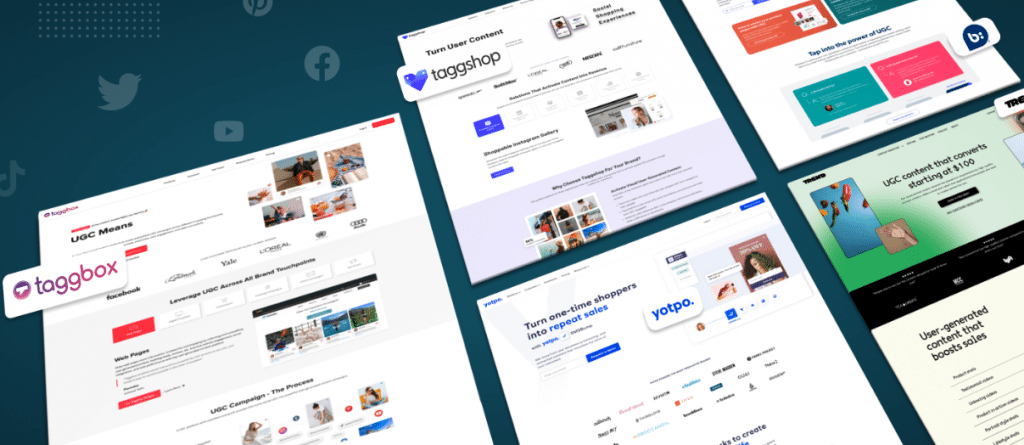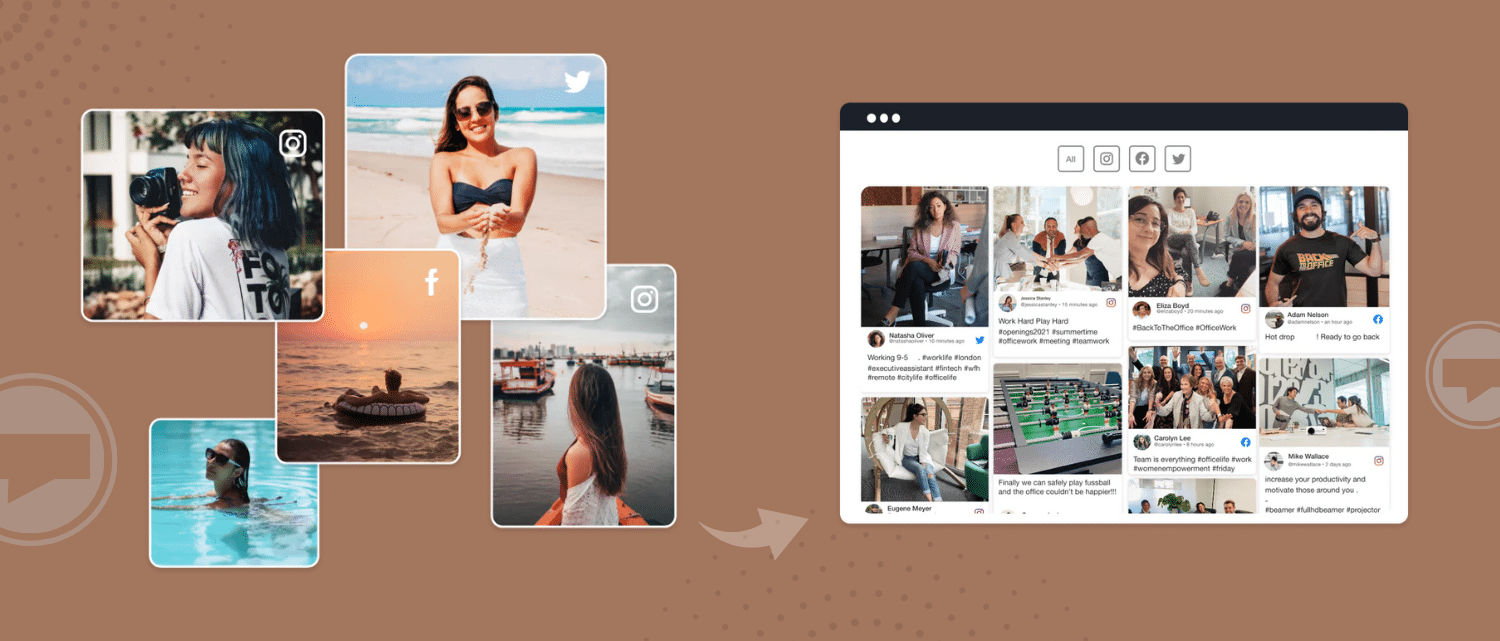The Missing Piece in Customer Loyalty – User Generated Content
According to the Oxford Dictionary, Loyalty means “a strong feeling of support or allegiance.”. This is definitely a dream for brands. While brands and marketers often have high customer expectations, it’s crucial to ask ourselves whether we are reciprocating by meeting their expectations or not.
You do? Many do; you need to give more than what they expect; only then will you be able to stand out and build customer loyalty.
It’s definitely not an easy task, as you can see that customers nowadays have numerous options to choose from.
But there is an easy way out; ever heard about User Generated Content (UGC)? No? You are at the right place. Let’s go!
What is User-Generated Content (UGC), and Why Does Your Brand Need it in 2024?
User-generated content, often abbreviated as UGC, refers to any content produced by unpaid contributors or, more simply, by your customers or users.
It’s the organic content that customers create, willingly or spontaneously, related to their experiences with a product, service, or brand.
This can encompass a wide range of content types, including
- Customer Reviews,
- Ratings,
- Testimonials, and
- Social Media Posts
It’s a must-have ✨ aspect of the modern marketing era, and its significance cannot be overstated.
Why Does Your Brand Need It?
If your brand is struggling to build customer loyalty and you’ve realized how challenging and resource-intensive it can be, I have a great solution for you: let me introduce you to ✨User-Generated Content.✨
Its unique qualities contribute to fostering stronger connections between customers and brands, ultimately leading to more loyal and engaged consumers.
Here is what UGC has to offer for your brand:
1. Authenticity:
Authenticity is the cornerstone of UGC’s power. In an era when consumers are bombarded with polished advertisements and marketing campaigns, UGC stands out as raw, unfiltered, and real.
When customers share their experiences, whether through reviews, social media posts, or testimonials, it’s perceived as genuine. Customer care folks know that best since they’re the ones keeping the communication going through various call center services, including cutting-edge cloud call center software.
Weaving in an office phone system that supports this direct, authentic interaction naturally aligns with the whole ethos, further bridging the gap between a company and its customers, ensuring every conversation feels personal and real.
This authenticity resonates with other potential customers, making them more likely to trust your brand. When people believe that a product or service has genuinely improved someone’s life, they’re more inclined to give it a try.
Thus, UGC contributes significantly to building customer loyalty through its inherent authenticity.
2. Trustworthiness:
Trust is the bedrock of customer loyalty. UGC leverages the trust factor in several ways:
- Peer Recommendations: Customers trust recommendations from their peers more than they trust advertising. When they see other consumers praising a product or service, it builds trust in the brand’s credibility.
- Unbiased Opinions: UGC is perceived as unbiased because it comes from real customers who have no vested interest in promoting the brand. This impartiality reinforces trustworthiness.
- Transparency: Brands that encourage UGC signal transparency and a willingness to accept feedback, even when it’s negative. This transparency cultivates trust among customers.
By highlighting trustworthiness, UGC strengthens the bond between brands and consumers, creating a loyal customer base.
3. Engagement:
UGC is inherently engaging, as it invites customers to participate actively in the brand’s narrative. When customers share their experiences, they become part of a community centered around the brand.
According to a study by Wikipedia, 90% of brands have seen an evident increase in their click-through rates using UGC in their ads.
This engagement can take various forms:
- Interactions: Customers engage with the brand by leaving reviews, posting photos, and commenting on social media posts. This active involvement fosters a sense of belonging.
- Word of Mouth: UGC often triggers word-of-mouth marketing, where satisfied customers recommend a product or service to their friends and family. These personal recommendations are incredibly influential in building loyalty.
- Content Creation: When customers create content, such as videos or blogs, about their experiences with a brand, they become brand advocates. This not only deepens their engagement but also extends the brand’s reach.
Incorporating UGC into your marketing strategy promotes active participation and engagement with your brand, reinforcing customer loyalty in the process.
User-generated content is a dynamic force that can significantly impact customer loyalty. It does so by offering authenticity that resonates with customers, trustworthiness that solidifies brand credibility, and engagement that fosters a sense of community and loyalty.
When harnessed effectively, UGC can be a game-changer, transforming satisfied customers into loyal brand advocates who stick around and actively promote your business. Now, you may be wondering how to encourage your users to create UGC. I got you!

How to Encourage UGC for Building Customer Loyalty:
Encouraging customers to contribute content actively can be a task.
Here are some advanced strategies and tips to inspire your customers to create UGC:
1. Create Exceptional Customer Experiences:
The foundation of UGC is exceptional customer experiences. Customers who love your product or service are more likely to share their positive experiences.
Focus on delivering outstanding service, exceeding expectations, and resolving issues promptly to create UGC-worthy moments.
2. Incentives and Rewards:
One of the most effective ways to encourage UGC is by offering incentives and rewards. Consider these:
- Discounts and Coupons: Offer discounts or coupons for online customers who leave reviews, share photos, or create content about your brand. This tangible benefit can motivate participation.
- Exclusive Access: Provide access to exclusive content, events, or products for UGC contributors. The allure of exclusivity can be a powerful motivator.
- Contests and Giveaways: Organize UGC contests and giveaways with attractive prizes. Make participation fun and rewarding, and highlight the chance to win valuable prizes as an attribute of your campaign.
3. User-Friendly Platforms:
Ensure that the platforms you use for UGC are user-friendly. This attribute is crucial for encouraging participation:
- Intuitive Interfaces: Make it easy for customers to share content on your website or social media platforms. Eliminate unnecessary hurdles or complicated steps.
- Mobile Optimization: Optimize your platforms for mobile users. Many customers engage with brands through mobile devices, so a mobile-friendly experience is essential.
- Clear Instructions: Provide clear instructions on how customers can submit UGC. Make sure they understand what you’re looking for and how to share it.
(CTA)
4. Engagement and Recognition:
Acknowledge and engage with UGC contributors:
- Thank You Notes: Show appreciation by sending thank-you notes or emails to customers who share content. Acknowledging their efforts goes a long way.
- Featured Content: Highlight UGC on your website or social media profiles. Featuring user-generated reviews, photos, or stories can inspire others to participate.
5. Storytelling:
Encourage customers to tell their stories related to your brand or product. This attribute is powerful because it humanizes your brand:
- Share Your Story: Share stories of how your product or service has positively impacted customers’ lives. Invite others to do the same.
- Emotion and Personalization: Encourage customers to share personal experiences and emotions connected to your brand. Emotional stories often resonate deeply.
6. Consistency:
Consistency is an important attribute in UGC campaigns:
- Regular Prompts: Periodically prompt customers to share their experiences. Consistent requests for UGC can keep the momentum going.
- Urgency: Create a sense of urgency in your requests. Highlight limited-time opportunities to participate, emphasizing the need for immediate action.
7. Community Building:
Build a sense of community around your brand.
- User Groups: Create online forums or social media groups where customers can connect, share experiences, and exchange ideas related to your product or service.
- User-Generated Events: Host events or webinars where customers can share their experiences live. This fosters a sense of belonging.
By implementing these strategies and tips, you can encourage customers to actively contribute to UGC, fostering customer loyalty while leveraging attributes such as incentives, contests, and user-friendly platforms.

Measuring Customer Loyalty Impact:
Now that we understand the significance of User-Generated Content (UGC) in building customer loyalty, it’s vital to measure its impact effectively.
Measuring the influence of UGC on customer loyalty allows businesses to gauge the effectiveness of their efforts and make data-driven decisions.
Here’s how you can go about it:
1. Customer Retention Rates:
Customer retention rates are a key metric for evaluating the impact of UGC. Measure how many customers continue to engage with your brand over time.
This attribute is a strong indicator of customer loyalty because it reflects the number of customers who choose to stay and continue their relationship with your brand.
Analyze the percentage of returning customers, as well as the reasons behind their loyalty.
2. Net Promoter Score (NPS):
NPS is another valuable attribute to consider when measuring the impact of UGC on customer loyalty. It involves asking customers a simple question: “On a scale of 0 to 10, how likely are you to recommend our brand to a friend or colleague?”
Those who score 9 or 10 are considered promoters, while those who score 0 to 6 are detractors. Subtract the percentage of detractors from the percentage of promoters to calculate your NPS via NPS Surveys. A rising NPS is often an attribute of increased customer loyalty influenced by positive UGC.
According to Salesforce, “the NPS methodology is primarily intended to measure customer loyalty to a company or brand – in other words, how likely they are to buy again, act as a brand ambassador, and resist pressure to defect. This last point can also be expressed as “churn rate” – that is, the likelihood of them canceling a subscription or not repurchasing. This is important because it is cheaper to retain a customer than acquire a new one.“
3. Social Engagement:
Social media platforms play a significant role in the distribution and impact of UGC. Monitor social engagement metrics such as likes, shares, comments, and retweets on UGC-related content. An increase in these attributes can indicate heightened customer loyalty driven by the resonance of UGC within your online community.
4. Customer Feedback and Reviews:
Review the content of customer feedback and reviews, especially those generated through UGC channels. Attributes to consider include the sentiment of the feedback and the frequency of mentions related to loyalty, trust, or brand advocacy. Positive sentiments and frequent mentions of loyalty-related attributes are indicators of UGC’s impact on customer loyalty.
5. User-Generated Content Reach and Impact:
Assess the reach and impact of UGC campaigns. Evaluate attributes like the number of UGC submissions, the reach of UGC-related hashtags, and the engagement levels on UGC posts. By tracking these attributes, you can understand how UGC contributes to customer loyalty and brand visibility.
6. Conversion Rates:
Measure the conversion rates of customers who interact with UGC. Attributes to consider include click-through rates (CTR), conversion from UGC-related content, and the correlation between UGC engagement and actual purchases. An increase in conversion rates is an attribute of UGC’s positive impact on customer loyalty.
7. Customer Lifetime Value (CLV):
Evaluate the CLV of customers who engage with UGC compared to those who don’t. Analyze attributes such as the average purchase frequency, average order value, and customer churn rate. A higher CLV among UGC-engaged customers can be a strong attribute of UGC’s impact on long-term customer loyalty.
By systematically measuring these attributes and metrics, businesses can gain valuable insights into how UGC is influencing customer loyalty. This data-driven approach enables them to refine their UGC strategies and strengthen their customer relationships over time.
Best Practices to Use UGC for Customer Loyalty:
Leveraging User-Generated Content (UGC) to foster customer loyalty requires a strategic and ethical approach.
Here are some best practices that big brands are using actively to utilize UGC while upholding values like transparency, responsiveness, and ethical usage:
1. Be Transparent and Authentic:
- Transparency: Always be transparent about the use of UGC. Clearly communicate how consumer content will be utilized, whether for marketing, testimonials, or product improvement. Ensure that customers understand their contributions’ potential impact.
- Authenticity: Seek genuine and unbiased UGC. Avoid manipulation of content. Authenticity builds trust with customers and enhances the credibility of your brand.
2. Encourage Genuine Contributions:
- Real Experiences: Encourage users to share their genuine experiences and opinions. Highlight that authentic stories matter more than promoting your brand. This approach ensures UGC reflects real, relatable experiences.
- Diversity: Aim for a diverse range of contributors to showcase a variety of perspectives. Encourage users from different demographics and backgrounds to share their unique stories and feedback.
3. Respond and Engage Responsively:
- Responsiveness: Engage with UGC promptly and constructively. Respond to comments, questions, or concerns raised by users in a timely and respectful manner. Demonstrating responsiveness reinforces a sense of community and engagement.
- Acknowledgment: Acknowledge and appreciate UGC contributors. Recognize their efforts by publicly thanking them, sharing their content, or featuring their stories. This acknowledgment cultivates a feeling of inclusion and value among customers.
4. Respect User Privacy and Rights:
- Privacy: Obtain explicit consent from users before using their UGC. Respect their privacy and ensure compliance with relevant data protection laws.
- Ownership: Clearly state the ownership and usage rights of the UGC. Make users aware of how their content may be used, ensuring clarity and transparency in usage terms.
5. Promote UGC Guidelines:
- Clarity: Establish clear guidelines and rules for submitting UGC. Clearly outline what type of content is acceptable and how users should engage. Providing clarity ensures that the UGC aligns with your brand’s values and objectives.
- Compliance: Ensure that UGC submissions comply with community standards and legal requirements. Monitor and moderate UGC to maintain quality and appropriateness.
6. Incorporate UGC Across Marketing Channels:
- Integration: Integrate UGC into various marketing channels, such as social media, websites, email campaigns, and advertisements. Ensure a consistent and cohesive brand message to maximize UGC’s impact on customer loyalty.
- Curation: Curate UGC thoughtfully to highlight the best and most relevant content. Showcase a variety of UGCs to provide a comprehensive view of customer experiences and opinions.
By adhering to these best practices, businesses can maximize the potential of User-Generated Content while maintaining ethical standards, promoting transparency, and nurturing customer loyalty.
A well-planned and ethical approach to UGC can lead to a strong bond between the brand and its audience, resulting in lasting customer relationships.

Challenges and Solutions:
Brands often encounter challenges when implementing UGC strategies. Here, we’ll discuss some common challenges and provide solutions, considering attributes like legal compliance, content quality, and privacy concerns:
Legal Compliance:
Ensuring that UGC complies with copyright, trademark, and privacy laws can be complex and challenging. Unauthorized content use or user data mishandling can result in legal issues.
Tagbox is the perfect solution for this; you can secure rights from the creators with our Rights Management and say goodbye to all the legal hassle.
Content Quality:
Maintaining content quality can be difficult, as UGC can vary widely in terms of relevance, accuracy, and presentation. Low-quality UGC may negatively impact brand perception.
Encourage high-quality UGC by providing clear guidelines and incentives for contributors. Attribute the importance of authenticity and share best practices with users. Invest in content curation to feature the most valuable and relevant UGC.
Privacy Concerns:
Balancing the desire for authentic UGC with privacy concerns can be a delicate attribute to manage. Users may be hesitant to share personal stories or images.
Attribute a strong privacy policy that respects user data and preferences. Encourage users to share content while maintaining their privacy. Clearly communicate how their information will be used and provide options for anonymity.
Negative or Inappropriate Content:
UGC platforms can sometimes attract negative or inappropriate content that can tarnish the brand’s reputation.
This is where Tagbox’s Moderation system comes in; with the help of this, you can control what is to be shown online from all your UGC assets.
Inconsistent Participation:
Not all customers may be willing to participate in UGC initiatives, leading to inconsistent engagement and limited content generation.
Incentivize and engage users through rewards, contests, or recognition. Attribute responsive feedback to contributions and demonstrate how their UGC contributes to the brand community. Attribute a variety of submission methods and platforms to accommodate different user preferences.
Scaling UGC Efforts:
As UGC initiatives grow, managing and scaling content moderation, curation, and engagement can become challenging, but whatever the issue may be, Tagbox has you covered with a solution to everything; this is why it is your UGC companion.
A thoughtful and proactive approach to these challenges can result in a successful and ethical UGC strategy. Now that you are going to invest in it let’s have a look at what the future of UGC looks like.

Future Trends of Customer Loyalty:
The landscape of user-generated content (UGC) and customer loyalty is continually evolving, influenced by emerging technologies and changing consumer behaviors. Here are some future trends and attributes to watch out for:
AI-Driven UGC Analysis:
AI-powered UGC analysis tools will become increasingly sophisticated, enabling businesses to extract deeper insights from user-generated content. Machine learning algorithms will identify sentiment, trends, and customer preferences more accurately, helping brands tailor their loyalty strategies.
Enhanced understanding of customer sentiment and behavior through AI will lead to more personalized and effective loyalty programs and marketing campaigns.
VR/AR Integration:
Virtual Reality (VR) and Augmented Reality (AR) will be integrated into UGC experiences. Customers can create immersive UGC content that allows others to virtually experience products or services.
This attribute will boost engagement and provide a unique way for customers to connect with brands, ultimately strengthening loyalty. Customers can try before they buy, and user-generated VR/AR content can serve as valuable reviews.
User-Generated Video Content:
The dominance of video content will continue to grow, with more users sharing video reviews, testimonials, and experiences. Short-form video platforms like TikTok and Reels will be important avenues for UGC.

Video content can convey emotions and experiences more vividly, creating stronger connections with viewers. Businesses that encourage and leverage user-generated video content will stand out and foster loyalty.
Interactive UGC Platforms:
Interactive UGC platforms will gain popularity. These platforms will encourage users to actively engage with brand content, such as interactive polls, challenges, and live streaming.

Increased interactivity will boost customer engagement and create a sense of community, contributing to long-term loyalty.
UGC in E-commerce Augmentation:
UGC will play a critical role in e-commerce, with augmented reality features allowing customers to virtually try products through UGC (user-generated content).
Customers will have a more immersive shopping experience, leading to increased confidence in their purchases and higher loyalty to brands that offer such features.
AI-Powered Personalization:
AI will be used to personalize UGC experiences for individual customers, ensuring that they see the content most relevant to their interests and preferences.
Highly personalized UGC will deepen customer engagement and loyalty, as customers feel that brands understand their unique needs.
UGC in Voice and Conversational Interfaces:
As voice assistants and conversational interfaces become more prevalent, UGC will extend to these platforms, with customers sharing their experiences and recommendations through voice.
This trend will enhance the accessibility and convenience of UGC, further strengthening customer loyalty.
As these trends continue to evolve, businesses that adapt and embrace new technologies and attributes in UGC will be better positioned to build and enhance customer loyalty in a rapidly changing digital landscape. Staying ahead of these trends will be crucial for maintaining a competitive edge.
The Curtain Call
In the realm of customer loyalty, User-Generated Content (UGC) shines as a potent tool. UGC’s authenticity and ability to build trust make it a key attribute in loyalty-building efforts.
UGC fosters communities, engages customers, and offers personalized experiences, driving brand loyalty. Ethical usage and staying ahead of emerging UGC trends are essential attributes for future success.
In a digital age seeking authentic connections, UGC stands as the beacon guiding brands toward lasting customer loyalty. So when are you getting started? Try Tagbox.
Schedule a Demo Now!

